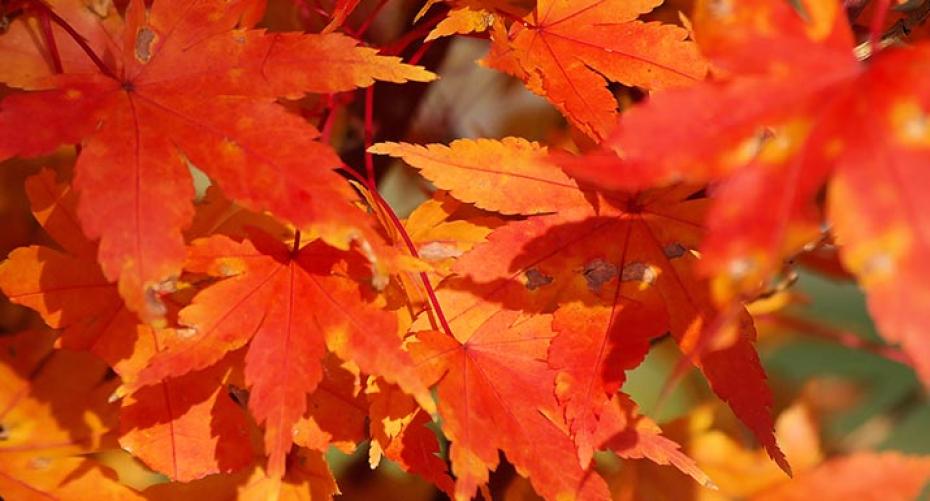The changing colour of leaves in autumn is caused by the shift in concentration of three photosynthetic pigments in the leaves, brought on by reduced daylight hours and lower temperatures. The three pigments represent green, yellow/orange, and red/purple. The leaf colour changes as these pigments break down and this is affected by environmental conditions, which explains why plants of the same species produce more spectacular colours in different geographical areas or from one year to the next. One of the most popular species for dazzling autumn colour is the acer and with over 400 different varieties to choose from there should be something to suit your garden.
 The most archetypal image when imagining a collection of acers is the Japanese garden where simple design is combined with stunning foliage shapes & colours. The flowing pathways which wind through the garden over dainty bridges & past ornately decorated buildings present a feeling of calm & well-being. The range of sizes & forms that acers take allows for a consistency in the planting whilst providing a varied display which comes into its own in autumn.
The most archetypal image when imagining a collection of acers is the Japanese garden where simple design is combined with stunning foliage shapes & colours. The flowing pathways which wind through the garden over dainty bridges & past ornately decorated buildings present a feeling of calm & well-being. The range of sizes & forms that acers take allows for a consistency in the planting whilst providing a varied display which comes into its own in autumn.
Perhaps the most important ally in achieving this is the Japanese maple or Acer palmatum. A deciduous tree with a history of cultivation well in excess of 300 years, Japanese maples have been grown in temperate areas outside Japan since the 1800’s. They are well suited to garden conditions because of their compact root systems which are unlikely to undermine paths, structures or compete with other plants. Many Acers have characteristics that are striking through the different seasons, including intense autumn colour, brightly coloured winter bark and fresh new growth in spring. Their style and compactness also makes them ideally suited to courtyard gardens.
 Acers are adaptable plants, but are unhappy in wet or dry conditions and find very alkaline soils difficult to cope with. Some shade is an advantage for green-leaved or variegated varieties which may be scorched by strong sunlight, but red leaves do need sun to develop their colour to the full. Cool dappled shade with protection from cold north or easterly winds will suit most acers & if you can’t provide this in the border you could choose a smaller variety & keep it in a container instead.
Acers are adaptable plants, but are unhappy in wet or dry conditions and find very alkaline soils difficult to cope with. Some shade is an advantage for green-leaved or variegated varieties which may be scorched by strong sunlight, but red leaves do need sun to develop their colour to the full. Cool dappled shade with protection from cold north or easterly winds will suit most acers & if you can’t provide this in the border you could choose a smaller variety & keep it in a container instead.
 Acers are available in a variety of sizes, some growing into small-medium sized trees at maturity. Acer griseum (paper bark maple), for example, may reach a height and spread of 6m. ‘Bloodgood’ (height and spread up to 5m) is always popular and the dark red-purple leaves take on a fantastic vivid red in autumn. For very finely cut leaves as well as colour, look to Acer palmatum var. dissectum whose varieties 'Inaba-shidare' ‘Garnet’ and 'Tamukeyama' are worth looking out for. If you prefer a golden coloured plant Acer shirasawanum 'Aureum' is a slow growing maple whose leaves are pale yellow in spring, darkening to yellow green in summer then turning gold in autumn with red leaf margins.
Acers are available in a variety of sizes, some growing into small-medium sized trees at maturity. Acer griseum (paper bark maple), for example, may reach a height and spread of 6m. ‘Bloodgood’ (height and spread up to 5m) is always popular and the dark red-purple leaves take on a fantastic vivid red in autumn. For very finely cut leaves as well as colour, look to Acer palmatum var. dissectum whose varieties 'Inaba-shidare' ‘Garnet’ and 'Tamukeyama' are worth looking out for. If you prefer a golden coloured plant Acer shirasawanum 'Aureum' is a slow growing maple whose leaves are pale yellow in spring, darkening to yellow green in summer then turning gold in autumn with red leaf margins.
As we move into October & the leaves are starting to turn colour prior to their fall it is an ideal time to select your own piece of autumn. This selection of Acers, plus many others that are available at the garden centre can provide you with your own peaceful haven right on your doorstep!


